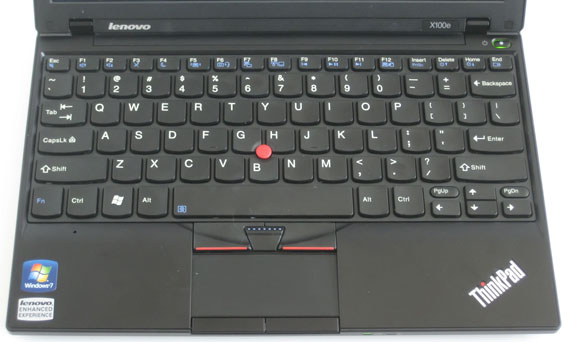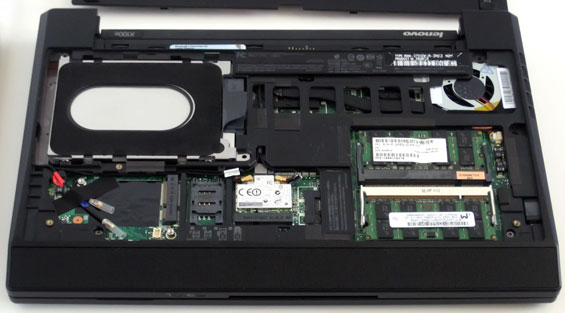Lenovo ThinkPad X100e: When Build Quality Matters Most
by Dustin Sklavos on September 3, 2010 6:40 PM EST
The ThinkPad X100e, On the Outside Looking In
The Congo platform in the Lenovo ThinkPad X100e seems positively ancient at this point, and popular response to our review of the MSI Wind U230 indicated as much. Nile is the new hotness and much improved in all aspects that count, so why the heck are we spending any kind of time on a notebook with outdated hardware? Because while Acer and Toshiba are happy to sell you Nile-based ultraportables in the same price brackets (and often cheaper than) Lenovo is hitting with its X100e configurations, Acer and Toshiba's notebooks aren't as solidly built.
Starting at the top, the X100e is all matte plastic; it's smooth enough to still pick up greasy fingerprints and smudges, but it feels very solid. You can order the X100e in traditional ThinkPad black or fire engine red, but the red looks atrocious even in photos. Classic ThinkPad black is the order of the day.
When you open the lid, you find the rest of the shell is made of the same black plastic, and the screen has a rarefied anti-glare matte finish instead of the glossy ones that are so common, making it much more usable in outdoor light. There's some flex to the lid as a whole, but it's not as bad as we've seen on other, larger notebooks (Clevo units are egregious offenders), and the hinges are nice and firm. There's also a webcam discreetly hidden in the bezel, above the screen.
Moving on to the body of the notebook, everything else is extremely firm. It's not quite at the level of the traditional ThinkPad-as-a-murder-weapon sturdiness, but the whole thing is also much smaller, and in a moment we'll see why it had to give up some of that rigidity. Port placement on the sides is fairly logical, although the massive blank space on the right hand side between the USB 2.0 port and Kensington lock seems like a wasted opportunity at first.

Of course, the real reason I bought the X100e is the keyboard. The chiclet-style keys may seem like heresy compared to the traditional ThinkPad keyboard, but the comfort and ease of use dispel any notions that this is anything but the best. And it really is absolutely the best keyboard you're going to find on a notebook in this size class, with near perfect travel and key depth. If you're a skeptic about chiclet-style keyboards, this is going to be the one to try before you write them off entirely. It's worth noting that while Lenovo placed the Fn key in the wrong place—outside of the Ctrl key—they were conscious enough of individual preference to allow you to actually switch the keys in BIOS. It's a small touch but a very welcome one.
In the neighborhood of the keyboard is another reason many people opt to pay the ThinkPad tax: the trackpoint placed in the center manages to be useful while not intruding on the typing experience. If the trackpoint isn't your speed, there's also an excellent touchpad recessed deep enough into the palm rest to prevent accidental misclicks and pointer movement during typing. The touchpad buttons are placed on the very bottom edge of the surface and work well, though I find I often use the buttons meant for the trackpoint despite mousing with the touchpad.

Finally, when we flip over the unit we find another welcome deviation from the norm: the entire bottom of the notebook, except for the speaker bar just under the front lip, is one large panel that can be removed. This is important: many manufacturers are extremely spare with letting you tinker at all with the insides of their notebooks. Under the panel you'll find, well, everything. You can see the cooling system for the chipset and processor at the top, the 2.5" drive bay, two slots for DDR2 RAM, the wireless half-card port, a SIM card slot for WWAN and an accompanying Mini-PCIe port for a WWAN card (complete with antenna connectors), and just under that port is even a smaller port meant for a Bluetooth daughter board (purchased separately, naturally.) Looking at the insides of the unit, at least we can see how efficiently Lenovo makes use of the limited real estate of the tiny ThinkPad. The right side is blank because the drive bay is butting up against that side of the notebook.
















24 Comments
View All Comments
Dustin Sklavos - Saturday, September 4, 2010 - link
That's true and it's an oversight I was somewhat conscious of during the review. In the end I went the direction I did because while more RAM can improve system responsiveness a bit during multitasking, the SSD shores up the whole package.Rick83 - Saturday, September 4, 2010 - link
Well, with modern Windows you also get lot of caching going on, further reducing the IO-load, and thus saving some more power.I think that actually the RAM-upgrade makes just as much a difference, as the SSD.
Did the same upgrade to an old thinkpad x60 tablet early this year, and the usability boost was huge (Also going from XP to 7 to have trim around..)
Megadunder - Thursday, October 28, 2010 - link
Did you do a SSD upgrade also? I have a x60 with 2GB ram and I'm thinking about a ram upgrade aswell as a SSD upgrade...allasm - Saturday, September 4, 2010 - link
When I needed a small portable laptop I bought a used Thinkpad X61s for about $500. It is a 12" unit (with matte and relatively low-res 1024x768 screen) and a low-voltage Core2Duo @1.6 (old tech 65nm though). Mine has 4GB DDR2 as well, and I got an intel 80GB SSD for it.The keyboard is excellent, and for me lower res on a screen 12" big is just right. Despite being older and 12" (and not 11") it weights the same 3.3lbs with the standard 4-cell battery, which is enough for about 3.5 hrs with a properly set up OS. It is a bit heavier with a larger 8cell battery, but then it is good for about 6-7hrs of internet surfing.
(on a side note, I'm amazed when netbooks which are 3 years younger with a smaller 10" screen and a much slower atom CPUs - and about the same battery life for 3-cell units - weight about the same as this X61s! Of ocurse, it used to cell for almost $2K, but hey, 3 years is a lot!)
Core2 @1.6 is more than enough for internet (including flash), and is good enough for some visual studio emergency development on the road as well. I never tried running any modern games though.
Of course YMMV when buying a used laptop, but I think the X61 line is still a good alternative if you need a small laptop more powerful than a netbook and don't mind (or want) a lower-res screen & good keyboard. Oh, did I mention it is very solid, and can live undamaged through a few drops as well (unfortunately, that was tested, heh)
Edgar_Wibeau - Saturday, September 4, 2010 - link
yuhong: I guess we won't see a Nile successor of the x100e because Ontario/Zacate aka Fusion is too close already. Don't know if IBM started developing a Nile based one and cancelled it for it's tiny time frame, I VERY STRONGLY hope that they'll have an x110e based on Ontario/Zacate soon in Q1 2011 though.I've virtually bought it already! :)
Decent review btw!
Edgar_Wibeau - Saturday, September 4, 2010 - link
Damnit, confused code names in my subject. Not Thuban but Ontario/Zacate of course :-/Zak - Saturday, September 4, 2010 - link
I had my hands on few Lenovo laptops recently, setting them up for the users, and they definitely feel more solid than Dell, HP or Toshiba. And they don't look hideous like most of the recent Toshiba and HP monstrosities. If I'm ever on a market for a laptop I would definitely look at the Thinkpads.LoneWolf15 - Saturday, September 4, 2010 - link
Don't count out Dell, or HP. The key is to look at their business-class lines, not their consumer models. Dell's Latitude line, and HP's Business Notebook line are good contenders.That said, I'm using my second ThinkPad , a T400 (my SO has my first, a T61, and loves it). They are very well built, and I can't do without a TrackPoint (though you can get those on Dell/HP business models as well). The keyboards are topnotch, too. The T-series and X-Series ThinkPads are great choices; the W-series is good too if you need a workstation-class powerhouse.
Yangorang - Sunday, September 5, 2010 - link
Did you experience any sort of hanging or freezing issues with your review unit? Because my x100e is hanging and freezing every now and then under Windows 7 x86 and x64. It works with XP quite fine though...kizzmequik - Sunday, September 5, 2010 - link
My girlfriend has one, and she's complained about some hanging when she first got it. A round of software updates apparently solved it. Or at least, she hasn't complained of any in a while.Unfortunately, those updates also included a wi-fi driver update that broke the wi-fi. I had to reinstall the original drivers, and it seems fine now.
Except that the Fn+F7 command (to extend display) sporadically pops out of nowhere to annoy the hell out of her. And me. Mostly me. Probably I should roll back the drivers and software for that, too.